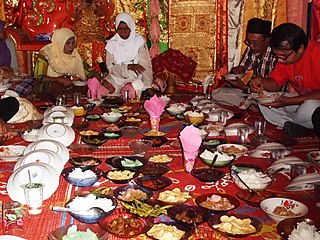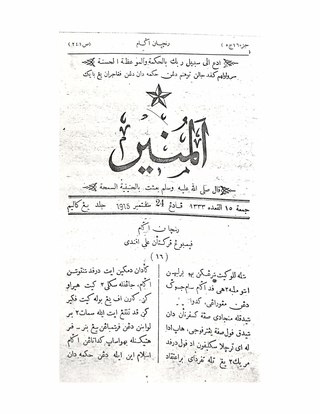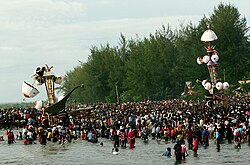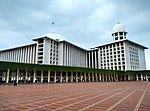
Minangkabau people, also known as Minang, are an Austronesian ethnic group native to the Minangkabau Highlands of West Sumatra, Indonesia. The Minangkabau's West Sumatera homelands was the seat of the Pagaruyung Kingdom, believed by early historians to have been the cradle of the Malay race, and the location of the Padri War.

West Sumatra is a province of Indonesia. It is on the west coast of the island of Sumatra and includes the Mentawai Islands off that coast. West Sumatra borders the Indian Ocean to the west, as well as the provinces of North Sumatra to the north, Riau to the northeast, Jambi to the southeast, and Bengkulu to the south. The province has an area of 42,119.54 km2 (16,262.45 sq mi), with a population of 5,534,472 at the 2020 census. The official estimate at mid 2022 was 5,640,629. The province is subdivided into twelve regencies and seven cities. It has relatively more cities than other provinces outside Java, although several of them are relatively low in population compared with cities elsewhere in Indonesia. Padang is the province's capital and largest city.

Ashura is a day of commemoration in Islam. It occurs annually on the tenth of Muharram, the first month of the Islamic calendar. For Sunni Muslims, Ashura marks the parting of the Red Sea by Moses and the salvation of the Israelites. Also on this day, Noah disembarked from the Ark, God forgave Adam, and Joseph was released from prison, among various other auspicious events on Ashura in Sunni tradition. Ashura is celebrated in Sunni Islam through supererogatory fasting and other acceptable expressions of joy. In some Sunni communities, the annual Ashura festivities include carnivals, bonfires, and special dishes, even though some Sunni scholars have criticized such practices.

Islam is the largest religion in Indonesia, with 87% of the Indonesian population identifying themselves as Muslims, based on civil registry data in 2022. In terms of denomination, the overwhelming majority are Sunni Muslims; the Pew Research Center estimates them as comprising ~99% of the country's Muslim population in 2011, with the remaining 1% being Shia who are concentrated around Jakarta and about 400,000 Ahmadi as well. Indonesia is the most populous Muslim-majority country.

Hosay is a Muslim Indo-Caribbean commemoration that is popularly observed in Trinidad and Tobago and Jamaica. In Trinidad and Tobago, multi-coloured model mausoleums or mosque-shaped model tombs known as tadjah are used to display the symbolic part of this commemoration. They are built and paraded, then ritually taken to the sea on last day of observance, and finally discarded into the water. The word tadjah derived from the Arabic word ta'zieh and signifies different cultural meanings depending on the region, time period, occasion, and religion. In Guyana, and Suriname, the festival is called Taziya or in Caribbean Hindustani tadjah in reference to these floats, arguably the most visible and decorative element of this festival.

Pariaman, is a coastal city in West Sumatra, Indonesia. Pariaman covers an area of 73.36 km2 (28 sq mi), with a 12 km (7 mi) coastline. It had a population of 79,043 at the 2010 Census and 94,224 at the 2020 census; the official estimate as at mid 2022 was 96,719 - comprising 48,864 males and 47,855 females. "Pariaman" means "safe area".

The Mandailing are an ethnic group in Sumatra, Indonesia that is commonly associated with the Batak people. They are found mainly in the northern section of the island of Sumatra in Indonesia. They came under the influence of the Kaum Padri who ruled the Minangkabau of Tanah Datar. As a result, the Mandailing were influenced by Muslim culture and converted to Islam. There are also a group of Mandailing in Malaysia, especially in the states of Selangor and Perak. They are closely related to the Angkola and Toba.

Ta'zieh means comfort, condolence, or expression of grief. It comes from the roots aza which mean mourning. It commonly refers to passion plays about the Battle of Karbala and its prior and subsequent events. Sir Lewis Pelly began the preface of his book about Ta'ziyeh maintaining that "If the success of a drama is to be measured by the effects which it produces upon the people for whom it is composed, or upon the audiences before whom it is represented, no play has ever surpassed the tragedy known in the Mussulman world as that of Hasan and Husain." Years later Peter Chelkowski, professor of Iranian and Islamic studies at NYU, chose the same words for the beginning of his book Ta`ziyeh, Ritual and Drama in Iran.

The mourning of Muharram is a set of religious rituals observed predominantly by Shia Muslims, largely during the month of Muharram, the first month of the Islamic calendar. These annual rituals commemorate the death of Husayn ibn Ali, grandson of the Islamic prophet Muhammad and the third Shia imam. Husayn and his small retinue were slaughtered in the Battle of Karbala on 10 Muharram 61 AH against the army of the Umayyad caliph Yazid ibn Mu'awiya. The battle followed Husayn's refusal to pledge his allegiance to Yazid, who is often portrayed by Muslim historians as impious and immoral. In Shia Islam, Karbala symbolizes the eternal struggle between good and evil, the pinnacle of self-sacrifice, and the ultimate sabotage of Muhammad's prophetic mission. Historically, the event served to crystallize the Shia community into a distinct sect and remains an integral part of their religious identity to date.
Minangkabau businesspeople refers to merchants from the Minangkabau Highlands in central Sumatra, Indonesia. Minangkabau are the ethnic majority in West Sumatra and Negeri Sembilan. Minangkabau are also a recognised minority in other parts of Indonesia as well as Malaysia, Singapore and the Netherlands.

Makan bajamba is the traditional communal meal, shared from one container, and procession of dining on low tables set upon the floor; it is a tradition of the Minangkabau people that has existed since the founding of Islam and is conducted at ceremonial events, holidays, festivals, and important gatherings. Various Minangkabau foods are served in the procession, which is carried in by female participants on their head. That foods are all laid out on metallic trays and then placed on the low tables and consumed while sitting on the floor. This procession opens with the performance of Minangkabau arts and begins with the recitation of traditional Minangkabau proverbs as well as proverbs from the Koran by elders and leaders. Literally, makan bajamba means eating together; it facilitates a sense of togetherness regardless of status of the participants.
Shi'a Islam in Indonesia represents a small minority in that largely-Sunni Muslim country. Around one million Indonesians are Shias, who are concentrated around Jakarta. Indonesian Shia are found in areas of Java, Madura and Sumatra.

Indonesia and Iran established diplomatic relations in 1950. Indonesia has an embassy in Tehran, and Iran has an embassy in Jakarta. Both countries are full members of the World Trade Organization (WTO), The Non-Aligned Movement, Organisation of Islamic Cooperation (OIC), and Developing 8 Countries.

Indang or Endang, also called Dindin badindin, is a traditional Minangkabau Islamic dance originating from West Sumatra, Indonesia. Indang dance grows and develops in the Minangkabau community as a portrayal of the arrival of Islam in West Sumatra in the 13th century.

Singkil people are an ethnic group of people found in Aceh Singkil Regency and Subulussalam, Aceh province, Indonesia.

Islam is the most common religion in the Indonesian province of West Sumatra, embraced by 97.42% of the population. The Muslim population increases to 99.6% if it excludes the Mentawai Islands, where the majority of the non-Muslim (Protestant) West Sumatrans reside. Islam in West Sumatra is predominantly Sunni, though there is a small Shia Islamic pocket within the coastal city of Pariaman. The Minangkabau people, indigenous to West Sumatra, comprise 88% of the West Sumatran population today and have historically played an important role within Indonesia's Muslim community. Up until today, the region is considered one of the strongholds of Islam in Indonesia.

Al-Munir was an Islamic magazine, written in Arabic-Malay, published in Padang from 1911 until 1915. Inaugurated by the initiative of Abdullah Ahmad in early April 1911, Al-Munir was listed as the first Islamic mass media in Indonesia. The magazine was often associated with Al-Imam magazine published under the direction of Sheikh Tahir Jalaluddin in Singapore during 1906-1909. In addition to Abdullah Ahmad, several religious figures such as Abdul Karim Amrullah, Muhammad Thaib Umar and Sutan Muhammad Salim were recorded in the ranks of the editorial board.
Burhanuddin Ulakan Pariaman, also known as Sheikh Burhanuddin Ulakan, was an Islamic cleric (ulama) from the Minangkabau region. He is regarded as the pioneer of Islamic propagators in West Sumatra. He is also known as a commanding figure of the Islamic movements against the Dutch colonization. Regarding his Islamic belief, he was a Sufi murshid belonging to the Shattari tariqa based in Minangkabau region.

Minangkabau culture is the culture of the Minangkabau ethnic group in Indonesia, part of the Indonesian culture. This culture is one of the two major cultures in the Indonesian archipelago which is very prominent and influential.

Music of Minang is a traditional and living genre of Indonesian music that grows and develops in the Minangkabau culture area. Music whose origins are related to Malay Music is generally played by musical instruments such as Talempong, Saluang, Minang rebab, Serunai, Tmbourine, Aguang, Gandang, and Violin. Minang music is also played to accompany various dances such as the Pasambahan dance and the Piring dance.























